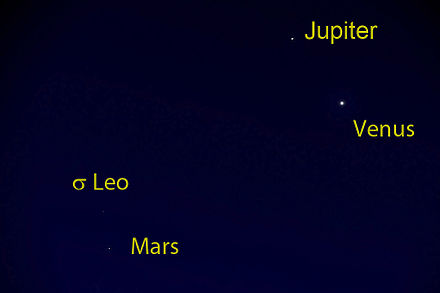Aspects of Venus
This article needs additional citations for verification. (July 2009) |

In astrology, an aspect is an angle a planet makes to another planet or point of astrological interest. As the second-brightest object in the night sky after the Moon, often prominent during the morning or evening, Venus has aspects that are readily apparent to the casual eye. They were of historical importance in the development of geocentric and ultimately heliocentric models of the Solar System.
Aspects of the planet Venus
[edit]The table contains special positions of Venus until 2021. In general, Venus (or Mercury) is an "evening star" when it has an eastern elongation from the Sun, and is a "morning star" when it has a western elongation.[1][2]
| Greatest eastern elongation | Greatest brilliancy | Stationary, then retrograde | Inferior conjunction | Stationary, then prograde | Greatest brilliancy | Greatest western elongation | Superior conjunction |
|---|---|---|---|---|---|---|---|
| March 29, 2004 - 46° | May 3, 2004 | May 18, 2004 | June 8, 2004 | June 29, 2004 | July 13, 2004 | August 17, 2004 - 45.8° | March 31, 2005 |
| November 3, 2005 - 47.1° | December 12, 2005 | December 23, 2005 | January 13, 2006 | February 3, 2006 | February 14, 2006 | March 25, 2006 - 46.5° | October 27, 2006 |
| June 9, 2007 - 45.4° | July 14, 2007 | July 25, 2007 | August 18, 2007 | September 7, 2007 | September 23, 2007 | October 28, 2007 - 46.5° | June 9, 2008 |
| January 14, 2009 - 47.1° | February 20, 2009 | March 5, 2009 | March 27, 2009 | April 15, 2009 | April 29, 2009 | June 5, 2009 - 45.9° | January 11, 2010 |
| August 20, 2010 - 46° | September 27, 2010 | October 7, 2010 | October 29, 2010 | November 16, 2010 | December 2, 2010 | January 8, 2011 - 47° | August 16, 2011 |
| March 27, 2012 - 46° | April 30, 2012 | May 15, 2012 | June 6, 2012 | June 27, 2012 | July 10, 2012 | August 15, 2012 - 45.8° | March 28, 2013 |
| November 1, 2013 - 47.1° | December 10, 2013 | December 20, 2013 | January 11, 2014 | January 31, 2014 | February 11, 2014 | March 22, 2014 - 46.6° | October 25, 2014 |
| June 6, 2015 - 45.4° | July 12, 2015 | July 23, 2015 | August 15, 2015 | September 5, 2015 | September 20, 2015 | October 26, 2015 - 46.4° | June 6, 2016 |
| January 12, 2017 - 47.1° | February 18, 2017 | March 2, 2017 | March 25, 2017 | April 12, 2017 | April 26, 2017 | June 3, 2017 - 45.9° | January 9, 2018 |
| August 17, 2018 - 45.9° | September 25, 2018 | October 5, 2018 | October 26, 2018 | November 24, 2018 | November 30, 2018 | January 6, 2019 - 47° | August 14, 2019 |
| March 24, 2020 - 46.1° | April 28, 2020 | May 13, 2020 | June 3, 2020 | June 24, 2020 | July 8, 2020 | August 13, 2020 - 45.8° | March 26, 2021 |
Note: Greatest brilliancy is often confused with "maximum brightness". Although they are related, they are not quite the same thing. The "greatest brilliancy" is really a geometric maximum: it occurs when the apparent area of the sunlit part of Venus is greatest. Only if the luminance of Venus' apparent surface would be constant (i.e. the same at every point and at every phase) would the "greatest brilliancy" of Venus coincide with its maximum brightness. However, the reflection of sunlight on Venus more closely follows Lambert's law, which means that the maximum brightness occurs at a somewhat larger phase of Venus than its greatest brilliancy.
See also
[edit]- Ashen light
- Hesperus (evening star), the planet Venus
- Phosphorus (morning star), the planet Venus
- Planetary conjunction
- Retrograde motion
- Transit of Venus
References
[edit]- ^ "What Is a 'Morning Star,' and What Is an 'Evening Star'?". Space.com. 2016-02-16.
- ^ McClure, Bruce (2017-04-29). "Venus at its brightest in morning sky". EarthSky.
Bibliography
[edit]- U.S. Naval Observatory. Multiyear Interactive Computer Almanac, 1800–2050.
External links
[edit]- Venus Phase Cycle, 1900–2050 (88 kB)
